One question that came often to me was “where do you find all that money to travel?“. Well, first, I don’t just “find it“, it’s my savings, and more relevantly for this post, “all that money” is relative. Cycle touring can actually cost less than just renting a room in Western Europe, and definitely much less than just surviving in Switzerland.
Contrary to a popular belief too often repeated to my ears, money doesn’t grow on trees of luxurious residences of White people, and European governments don’t pay their citizens to see how poor is the rest of the world (it could be a good idea, though). On the other hand, having a job in Europe, let alone in Switzerland, makes it very easy to save, especially in comparison with the salary of an unskilled worker in Africa.
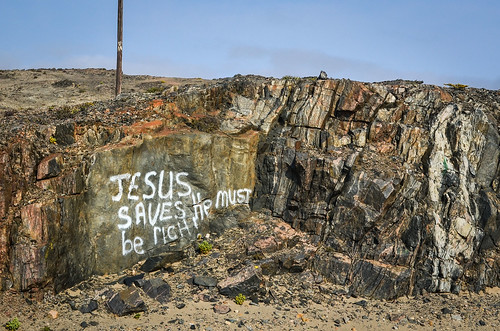
I kept a record of all my spending on that journey, so I’m detailing it below. For better referenced data on budgeting cycle touring, excellent stats can be found there: TheNextChallenge: How Much Does it Cost to Cycle Round the World?
The average monthly cost of a cycling trip over 10,000 km is 760 € (mean) and 535 € (median) The costs range from a low of 80 € per month to a high of 5800 €. This is based on a sample of 131 cyclists who have completed journeys of 10,000 km or more.
I’m below the average. My detailed expenses are gathered on my Stats page. I’ve spent 8560 € for 1 year and 10 months on the road, which makes an average of 390 € per month, or 13 € per day, or 0.32 € per kilometer. Considering that roughly half of this money is spent on food, it’s logical that a trip in Africa costs less than a trip in Europe. Well, depending on the lifestyle, it’s of course possible to spend a lot in Africa, and much less in Europe. The cheapest guys of the LDCJ database have lived (survived?) more than a year cycling Europe with less than 3 € per day.

Interestingly enough, in Europe, for my first 3500 KM (charts here), the spending share was 65% food and 5% accommodation. In 4 European countries, I cycled 3515 km during 57 days: it’s 670 € per month, or 22 € per day, or 0.35 € per kilometer.
Food.
I’m not good at cooking, so if I can buy food ready instead, I’ll go for it, and for the cheapest version of it. If I’m camping, or if there is no warm food for cheap, I would cook spaghetti.
In Europe, it means bread+cheese+saucisson, which is overpriced and untasty in Switzerland, but perfect in France and Spain. For all three countries, I reach an average of 14.2 € of food per day. Had I cooked spaghetti all the time, it could have been much much less. I’ve done only a few restaurants in Spain, when it was cheaper than buying cheese and saucisson in a supermarket, and when free wifi was included.
In Africa, it’s almost opposite. I have spent there in average 5.2 € of food per day, still much higher than if I had cooked spaghetti all the time, but very decent considering I was “eating out” most of the time. For lunch, I would stop by the road as soon as I am hungry and buy from the first lady selling food. As often as I am hungry, so it can easily be several times a day! For dinner, I would cook my spaghetti if I am camping, or roam in the village if I am staying “in town” until I find the cheapest deal for the quantity of food I need. I carried much less with me: cookies are bad, cheese and saucisson don’t exist, bread is rare … it’s not really a place for packaged and transportable foods, apart from fruits and bâtons de manioc. Supermarkets “for expats” (European food) are only located in capital cities and are too expensive anyway (prices at least double compared to Europe). Other supermarkets (mostly Lebanese-owned) are great to refill on pasta, but that’s it.
There is also an obvious difference between densely populated places and jungle places (Gabon, Congo). In the latter, people only cook for themselves and it’s much harder to find “the lady who cooks by the road”.
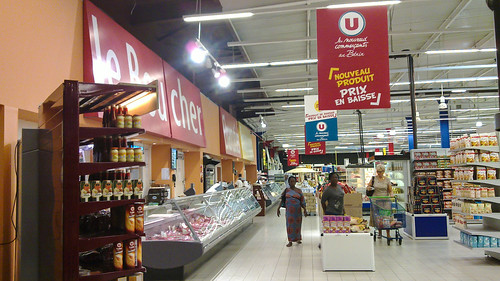



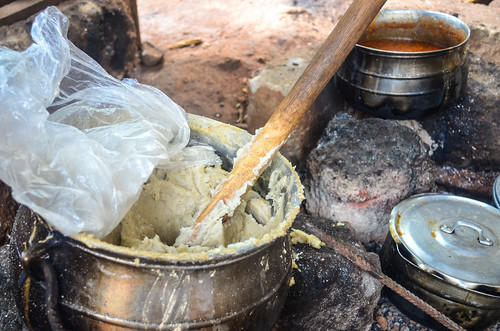

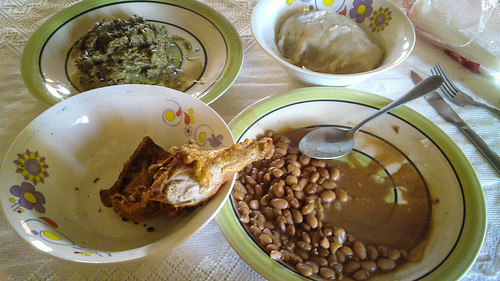
So in short, instead of cooking, I’ve always looked and bargained for the cheapest food, but always ate as much as I needed (which is often and a lot). I never went to any fancy restaurant, and even the photos above are making my diet rather appealing. I was at first relieved to leave Senegal, where I was a bit fed up of eating a thiéboudiène a day, until I realized that no national dish of my next countries would be as tasty and assorted as a thiéboudiène. My photos don’t tell how many plates of rice with cassava leaves I’ve eaten in Sierra Leone and Liberia, how finding aloko in Ivory Coast, when I’ve eaten attiéké with small dried fishes for lunch and dinner almost every day, is like finding gold, and how sad it is to realize that canned sardines with bâtons de manioc are actually considered as staple food in Gabon.
I’d say Morocco had the best food, and Cameroon was pleasantly diverse. I didn’t explore Nigeria’s markets as much as in other countries, but it was interesting. I’ve enjoyed a lot camel sandwiches in the Sahara, bush meats like porcupine, cassava foufou when made with the stiff texture of the Ivorian plakali or Nigerian eba, all the soups and sauces in Cameroon, the donuts/dough balls/beignets, especially when made from bananas, plenty of peanuts, entire grilled fishes with miondo, etc. I feel I’ve eaten more cassava than during that trip than anything else. I lost 7-8 kilos between Liberia and Angola, that I quickly recovered in Namibia and South Africa, where, finally, meat gets the treatment it deserves.
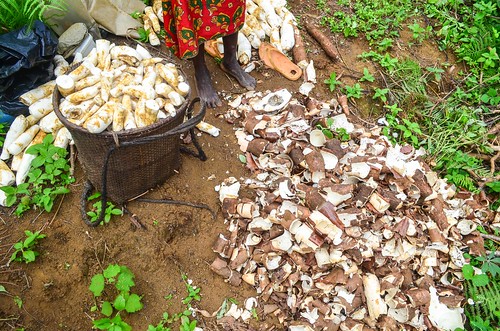

My Stats page lists my food expenses per country, but it must be read in context. For example, for comparable quality and service, Angola is much more expensive than Morocco, but I have spent more in Morocco, because I have jumped on every tagine (at least the ones for 2) whenever I saw the delicious hat-shaped dishes waiting for me by the streets of small towns. I spent less in Angola, simply because nothing was worth the money (except the visa extension). That’s where cycle touring is almost the opposite of being a tourist, the freedom of carrying my whole house with me giving me the choice: if I don’t want to pay for something, I just do it myself.
These food costs include drinks. I never bought drinking water: I didn’t need to, and at 5 to 10 L per day, that would have costed more than food. But depending on the heat, I would not resist an ice-cold coca-cola or other soda. It’s roughly 0.8 € per can, so I became very knowledgeable at the pricing of cheaper and returnable 25 cl and 50 cl glass bottles. Water and beer cost more or less the same. Or, beer is sometimes cheaper. For example, it’s cheaper than a coke in the Gabonese rainforest, because people buy more beers than coke (Economics 101 of the jungle).
Accommodation.
Accommodation only accounted for 16% of my expenses, which means I’ve roughly spent the same amount of money on hotels as I did on getting visas to enter the countries in the first place.
The chart below is drawn from 356 nights at the end of cycling days. The type of accommodation of my rest days, when I don’t change location, is not counted. Expenses during rest days, however, like several hostel nights in a row, are accounted for. So in short, this chart just illustrates my different options at the end of a day I spend in translation, which I almost always start in the morning with no idea of where I’ll be at sunset.

This has nothing to do with money, but with hospitality and stories: I’ve spent one night in five (section Host) at a stranger’s house, met on the road, or while discussing about camping. I’m never forcing hospitality the way Antoine de Maximy does, and I also declined several invitations when I didn’t like the timing (like when I hadn’t cycled enough). At the end of the day, either I hide in the bush (if I want to sleep well) or I ask permission to the chief of the village to camp nearby (it would be rude not to, if I’m already spotted by villagers). In the latter case, I’ve been often invited to share a meal and/or a spare room. And it’s the best way to learn about local sights, stories, work, customs, and food.
I’ve spent one night in four at a cheap hotel, and that’s quite a big share, but after I realized that even small towns had a fair number of rooms for 5000 CFA (7.5 €) or less, I became lazy: when it was raining, instead of camping and being wet, I would just stop at the nearest room and bargain for the cheapest price. With this price was included electricity (at least until midnight if the hotel ran on generators) and shower water (often cold and in a bucket). I have only had hot shower once or twice per country. Cold water being always at 25° or 30°, it’s not like taking a cold shower in Europe in winter.
Camping means wild camping most of the time. After Senegal and until Namibia, I don’t remember having seen a campsite. If one wants to sleep outside anyway, why would he have to pay? I have done several campsites in Namibia, where they cost a bit more than N$ 100 (= 5000 CFA, the price of a cheap hotel in West Africa), because they all have hot water and electricity!
CouchSurfing doesn’t have many members, not many have filled out profiles, and too few hosts have recent activity anyway. But most of all, it’s hardly compatible with my liking of not knowing which road and which town I’ll visit the next day.
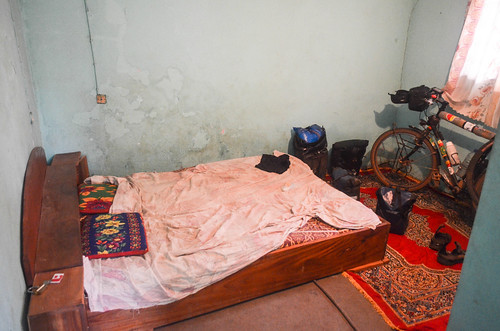
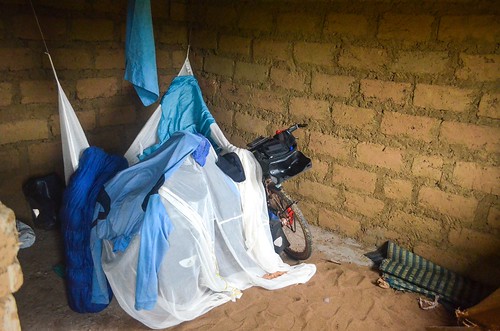
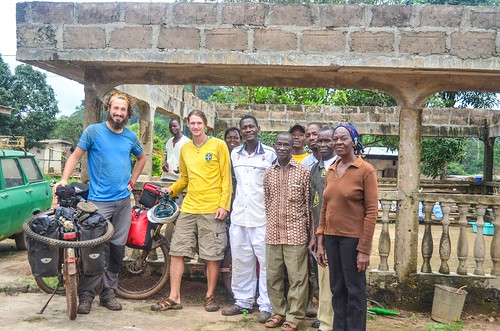


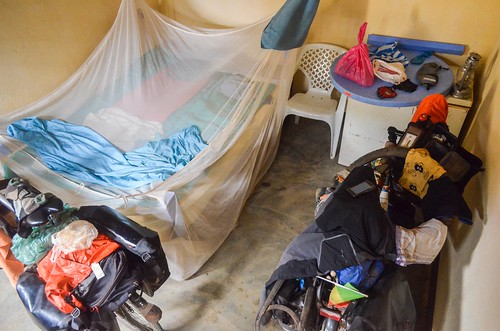
Transport & Visas.
This category (15.4% of my total spendings) contains the transport costs for when I was not moving on my bicycle: that’s only ferries and boats across rivers (including Gibraltar), and a few collective taxis on my rest days. However, most of this amount is actually visa fees collected by Embassies: I gave them 1020 € in total, which makes 11.9% of my total cost. It was not the case in the past century, but now that the EU asks all Africans to obtain a visa, African countries simply retaliate. It’s not a smart but a fair game. Maybe not so fair in the case of Liberia: small country in ruins, 135 € for the tourist visa, plus 15 € once inside the country?
I always applied for visas at Embassies of previous countries, because only Togo officially grants it at the border. For other countries, one may get lucky at land borders, but chances of getting unlucky are too high for risking a U-turn and cycling back to the capital city.
I’m giving my full list of visas, city of application and costs, since it seems to be the most sought information by travelers, but I don’t think it’s useful, as procedures often change, and many immigration officers have no clue on how a visa works. Obtaining visas on the road is just part of the adventure.
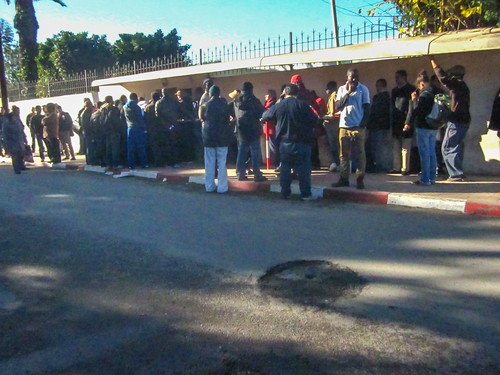

Equipment.
The only field in which I only bought the most expensive stuff. Not the really the most expensive stuff, but the highest quality, which is the second most expensive bike stuff, after hipster bike stuff. The closest places to get quality stuff is Europe or South Africa, so it has to be well planned. I’d rather eat cassava every day for a month rather than breaking a Rohloff speedhub on a flooded road of a country whose post office barely works.
Luckily the Rohloff didn’t break, and I only had to replace things that wear off. New tires, new chains, new pants, new USB cables, new shoes, more oil, more spokes, more tape, more super glue, sum up to 1050 € of running costs (12.3%) for 20 months on the road.

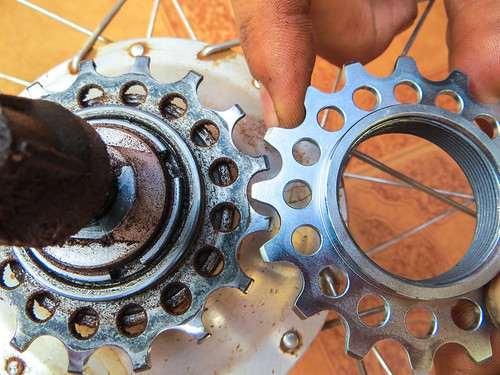
I have not mentioned the price of the initial equipment: there was about 6000 € worth of things under my butt. It’s more or less a third for the touring bike, a third for the touring-related equipment (panniers, camping gear, cooking gear), and a third for the rest (clothes, camera, laptop, phone, stuff). I bought half of it for this trip (the bike and the panniers), while I already owned the other half, or would need it anyway, even without starting this journey.
I’m glad I had straight handlebars and 2″ tires, because I did 34% of my African distance on dirt roads. The amount of dirt roads per country on my Stats page is not indicative of the average roads quality. For example, I stayed 90% on tar roads in Nigeria on purpose, so as to go as fast as possible, while I cycled 66% on dirt road in Namibia, which has an amazing road network, because they’re much more beautiful. I never thought I’d spend so much time away from the tar, but I now think it’s much better, and that cycle touring on tar roads is actually boring.
Communication.
It’s internet! Mostly internet, since the few postcards I sent are trivial compared to the many prepaid SIM cards and airtime credit I bought, totaling 6.1% (26 € per month). It’s more than high-speed internet + unlimited calls + TV in Europe! I didn’t realize it, since I always spent very little on it: For example, 1000 CFA every 2 days, and some full days negotiated at a cybercafé to upload my pictures and blog.
Internet is not hard to get, the 2G coverage is pretty good everywhere I’ve been in West Africa, even in the countryside, and 3G in some cities. Once in Central Africa, it’s another story (my version of Central Africa includes Cameroon, Gabon, Congo and Angola (I know Cameroon is kind of West and Angola is kind of Southern, but from a cyclist point of view, there is a before and an after Nigeria, and the infrastructure gap at the border Angola/Namibia is as sharp as Spain/Morocco)). There, 3G doesn’t exist even in the largest cities, and the infrastructure globally looks much poorer. There’s less food and higher prices. And it seems to be also where oil and gas is plentiful. I guess that what they call the “resource curse“, and the Economist’s map illustrates well that the ones doing best are the ones drilling with moderation. It seems to correlate with this map of conflicts (source and methodology here), and it wouldn’t be surprising if the two were related.


Conclusion.
I bought all what I needed, and nothing more. I find these 8560 € poured into 20 months of traveling a very good investment. It’s a fraction of the cost of a MBA program, it’s cheaper than a month in Dubai instagramming luxury hotel rooms, it’s less than what Chinese tourists spend in a week traveling abroad (excluding accommodation), but it’s so much more rewarding!







JB,just so you know how appreciated your in-depth invaluable information is.Although I will browse through every bit of information, I realise everybody’s Adventure is so different.i cycled from Rio to George Town in Guyana ,not sure if anyone as done that before or after.My only issue was visa’s for this part of the world. You have answered all my questions.what a superb epic journey,.best of luck with your future adventures. I am cycling this route, when I have or indeed when the time is right when ever that will be in 2023. My bikes under construction at Koga. .incredible trip and information. Thank you my friend.
Thanks for your words Mick. Cycling in the Amazon sounds incredibly tough! I wish you good luck with the prep and dry roads once you’re there 🙂
Thanks for so much useful content. I was thinking on making this trip only from Senegal to Benin. How long do you think would be a good time for this part of the route? And how about safety? Did you had any issues? Were you fine to just make wild camping in west Africa?
when you are applying visa in foreign country you have to give your passport to the embassy,right? and it will take 2-3(approx) days to get the visa. so how do you travel this 2-3 days without a passport in a foreign country?
That’s correct. While my passport is at an embassy, I stay in the city, and carry a certified copy in case I am controlled.
Congratulations for the accomplishment and thank you for the loads of useful information on your site. Unfortunately I don’t have the chance to take such a long time off but I’d love to do part of this trip one day. By the way, I see you travelled with a friend. Would you do this with a girlfriend/wife? Or which countries would you avoid in that case?
Je suis très admirative de vos performances. Quelle belle collection de souvenirs vous vous êtes faits pour les jours de retraite…..
Moi, j’avais fait le Sahara, mais en voiture…. lol
Hello Jean-Baptiste! What a great mad adventure and amazing website 🙂 Me and my boyfriend are planning to cycle from England to Cape Town (through East Africa) and we set off in a few weeks time! Your blog is very helpful, thanks for your advise 🙂
Kind regards
Maya
Good luck! Let me know when you reach CT. It should be easier and cheaper for your visas on the East side (and for sure shorter too 🙂 )
Superbe!
My wife and I recently returned from a 12 month budget trip around Europe and Asia and I must say traveling on a budget was very rewarding. A lot of people asked us how we could afford it and were surprised when I told them how little it ended up costing us. We didn’t cycle our way, so for us probably the most expensive part was transportation, with food and lodging being close 2nd and 3rd.
My hat is off to you for your cycling accomplishment!
Thanks! Indeed, lots of people think all kinds of travels are expensive, whereas cycling offers you the possibility to control almost every expense. So far I think India / SE Asia offers the best value for money, but I’ve not been everywhere yet!
Yeah !
C’est bien moins cher de rouler à vélo que de polluer avec un gros van !